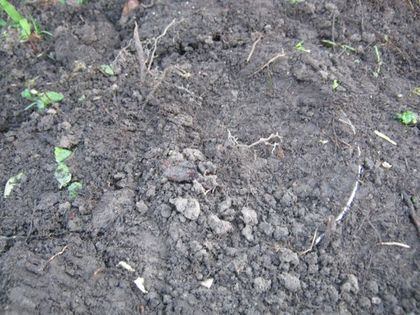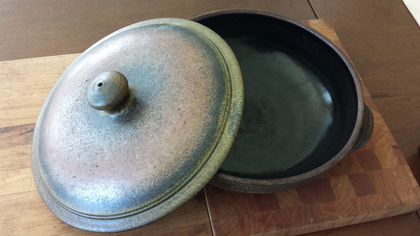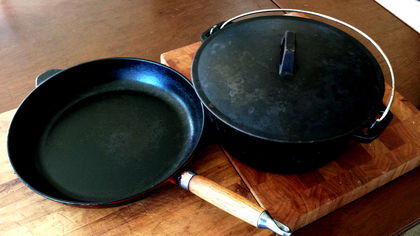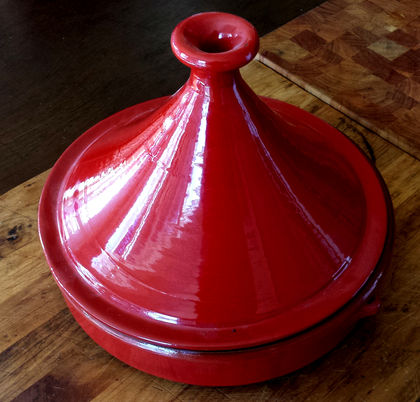Hard News: Tooled Up for Food
151 Responses
First ←Older Page 1 … 3 4 5 6 7 Newer→ Last
-
We have a couple of Le Creuset casseroles/dutch ovens/whatever they’re called, which we’ve had for 13 and 14 years respectively. I thought they were good until we bought “temporary” IKEA cookware for our 18 month stint in the UK. That cookware included the “Senior” cast iron casserole (http://www.ikea.com/gb/en/catalog/products/70131724/). The interior is cast iron rather than the Le Creuset enamel. I don’t know why (possibly someone will tell me) but it did a far better job of browning onions and generally making things yummy, and was perfect for getting a good crust on sourdough, and every week I regret not including it in our (minimal) shipping home.
However, we were glad to come home to the WMF frying pan that my aunt gave us for a wedding present. Also 13 years old, doesn’t look it, and still going strong.
-
Orange peelers. Is this what you were looking for? (I haven't found any in NZ or Australia):
http://www.fishpond.co.nz/Kitchen/2-pc-Orange-or-Citrus-Peeler/0062823809055
http://www.pamperedchef.com/our_products/catalog/product.jsp?productId=18&categoryCode=KW
http://www.plumbersurplus.com/Prod/Ekco-1045651-Orange-Peelers-4-Pack-Orange/203945/Cat/1556
-
Something I overheard, in a British homeware store, regarding Le Creuset enamel: one way to destain the enamel inside the pot is by filling it with a solution of Sterident, or an equivalent (the material used to soak dentures overnight). In my limited experience, it works pretty well.
-
A thick paste of baking soda and water works ok too.
-
B Jones, in reply to
I don’t know why (possibly someone will tell me) but it did a far better job of browning onions and generally making things yummy, and was perfect for getting a good crust on sourdough,
I tried to find out, but only got this far. It's probably whatever that physical property is that makes glass feel cooler than plastic and allows people to walk over hot coals providing they move quickly. A surface transferring more heat will generate more caramelisation and Maillard reactions, and more tastiness.
-
Hebe, in reply to
Orange peelers. Is this what you were looking for?
Exactly! You are an angel: I had never thought of google -- I associate that gadget with 1970s Kiwi suburbia so had only looked in op shops!
-
Gareth, in reply to
Also they have a slight tendency to cause owners to rave about their virtues.
I noticed. And that is why I'm suffering BBQ envy. But they're not cheap. Will need to sell loads of truffle...
-
Islander, in reply to
Gareth - I am really interested in black truffles - but not yet quite rich...if you email a price, I will do a bit towards new bbq thingies...
-
BenWilson, in reply to
And that is why I’m suffering BBQ envy.
Me too. That is a fit piece of gear.
-
BenWilson, in reply to
A surface transferring more heat will generate more caramelisation and Maillard reactions, and more tastiness.
The thermal conductivity of aluminium is around 3 times higher than iron. It also has over twice the specific heat, so per mass it is more resistant to temperature change, holds much more energy. But it is far less dense, nearly 3 times less. So an aluminium pan weighing half as much as an iron one would have the same thermal mass properties, but with a much higher ability to transfer heat into the food. It would be 3/2 times the volume of the iron pan (despite being half the weight).
I expect that they're not used as thermal masses for different reasons. For starters, pots and pans are usually coated in non-stick materials which can't stand very high temperatures - Teflon melts at 327 C. Aluminium itself melts at only 660 C, whereas iron can take up to 1538 C. So if you like to leave your pan to warm up on a gas hob, you've got a good chance of ruining a teflon coated aluminium pan. Secondly, if you're using aluminium, it's probably because you want it light, and who really does understand about specific heat? Not most consumers.
Which comes to the main real difference - iron has just been around so much longer that all the of the recipes and techniques are built around it. You have use a different tool differently, so a recipe designed for a cast iron skillet needs to be changed for an aluminium pan. Similarly with a cast iron vessel in an oven - you probably won't melt aluminium in an oven, but a thin aluminium tray transfers heat much faster, so your cook time should probably be adjusted down, or the oven heat reduced (or both). When you take it out, the aluminium will cool faster (since it is typically very thin - you chose aluminium for it's light weight, rather than its thermal mass). This can be pretty easily avoided by not taking it out, just turning off the oven and opening the door a bit for a gradual cooling.
Aluminium is also more toxic than iron.
On thermal mass, a strange fact I learned this year. Water has an astoundingly high value. It holds ten times as much energy per kg than iron. So if you have a skillet full of boiling water, consider that there is probably more energy in the water than in the pan itself. A 2kg iron frying pan would be holding as much energy as 200ml of water at, say, 100 C. It is the water that is keeping everything in the pan at an even temperature, on the whole.
-
Which I guess is why when you eat a dish that's otherwise not too hot, you burn your tongue on the tomatoes and other watery bits.
I made flour tortillas last night, and used my old Murray copper-bottomed pan for it - great when you want a hot pan and don't want to trash your teflon. It's probably as old as I am, but doesn't have the slightest warp to it, and you can always get the burn marks off it eventually.
-
BenWilson, in reply to
you burn your tongue on the tomatoes and other watery bits.
Yes, they're perfect little heat bombs. It's a good characteristic, so long as you know in advance.
-
-
Ok - I'll work on that rotation
-
-
-
-
Russell Brown, in reply to
A 70’s era very wide but shallow casserole which is perfect for very long, slow cooking. It’s so big I rarely get to use it.
That's nice. It's the same shallow profile as my fancy-ass Tramontina. It's a shape that works rather well.
-
Hebe, in reply to
The cast iron
In my old cast iron suite almost the same, the lid fitted the frying pan to make the shallow dish cooker thing. The frying pan had the loop iron handle rather than the wooden one so it could go in the oven, lidless or with lid. That handle was the main reason I gave away the set: I grabbed it ungloved one too many times when I was using it on the stovetop.
-
Thrash Cardiom, in reply to
It's a great dish for chunky bits of beef slow cooked for hours. That said, I have a couple of friends who have some 3 year old, farm raised but unwanted roosters which I think would be perfect for a coq au vin. I'll probably do them in this casserole.
-
Thrash Cardiom, in reply to
Yes, I have one of those loop handled pans as well. It's quite bit smaller though so it doesn't get as much use. I too have grabbed the handle unthinkingly.
-
If you live in Auckland check out http://www.home-essentials.co.nz , a store in New Lynn opposite Lynn Mall (in the block on the corner of veronica and great north). A lot of top-end stuff at half the ponceonby prices.
-
I would put up a picture of the best cast iron frying pan we ever had, but we gave it away.
When we first set up our household, we were broke. Really, really broke. So we bought various kitchen items from the Warehouse, reasoning that we would replace them bit by bit when we had a bit more money. One of the things we bought was a cast iron frying pan, for about $20.
It was superb. I seasoned it properly, and we looked after it, so it quickly built up a lovely patina. But a few years later, my parents gave us a Le Creuset cast iron pan, which I duly seasoned, and we started using it. It didn't build up a patina as quickly, but it was doing okay.
Then there was a bizarre crime in the small village where we were living. Some of you will recall it: a detective was tied up and tortured, and then his house was doused with petrol and set alight. He managed to get out the window just in time. Very fortunately, his wife and children were away at the time.
Being a small village, the local community rallied around to find furniture and appliances and linen and kitchen ware for the family, because they had lost everything. We looked at our two cast iron frying pans, and decided that we didn't really need two. So we gave away the Warehouse frying pan.
I've regretted it ever since. Not only did it turn out that the detective had set up the crime himself, but the expensive Le Creuset pan has just never, ever, developed the same patina as the Warehouse pan. I season it regularly, and never wash it in soapy water, but somehow, it just doesn't ever get that nice, oily sheen.
Some people in the village did go and demand their stuff back, but we didn't: the detective's wife and children had still lost everything. But I hope they've enjoyed using that pan.
-
Russell Brown, in reply to
Some people in the village did go and demand their stuff back, but we didn’t: the detective’s wife and children had still lost everything. But I hope they’ve enjoyed using that pan.
What a story!
-

This is my stockpot.
"What stockpot?" you say.
That would be the stockpot buried in the garden. You can see the rim on the right hand side of the photo. My daughter was cooking up rice for sushi, but alas, she misjudged the amount of water, or time needed, or something, and the bottom of the pot is very black indeed. We tried soaking it, and scrubbing it with steel wool, but it didn't work. So now we've resorted to the old trick of burying it in the garden, in the hopes that bacteria in the soil will deal to it. It's been in there for a week now, and in the meantime, I am stockpotless, which is a dire state to be in when I want to make big winter soups.





Post your response…
This topic is closed.